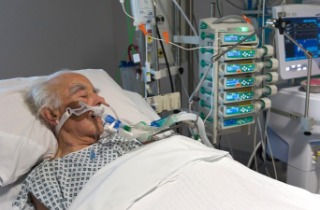The new protocol does not support intubation.*
*Results in 100% fatality
It is an oxygenation failure, not a respiratory failure
The paper admonishes vs use of ventilators to prevent mechanical injury. Let nature heal the patient, according to their literature
https://www.evms.edu/media/evms_public/departments/internal_medicine/EVMS_Critical_Care_COVID-19_Protocol.pdf?fbclid=IwAR0Ra7gzMrBhtVk7W2GMZjNrdeCGajDByxkw6hSAg5OJo6wTXJpp-qBVw5Y
Intubation is not recommended
Prophylaxis While there is very limited data (and none specific for COVID-19), the following “cocktail” may have a role in the prevention/mitigation of COVID-19 disease. While there is no high level evidence that this cocktail is effective; it is cheap, safe and widely available. • Vitamin C 500 mg BID and Quercetin 250-500 mg BID • Zinc 75-100 mg/day (acetate, gluconate or picolinate). Zinc lozenges are preferred.
After 1-2 months, reduce the dose to 30-50 mg/day. • Melatonin (slow release): Begin with 0.3mg and increase as tolerated to 1-2 mg at night • Vitamin D3 1000-4000 u/day (optimal dose unknown). Mildly Symptomatic patients (at home): • Vitamin C 500mg BID and Quercetin 250-500 mg BID (if available) • Zinc 75-100 mg/day • Melatonin 6-12 mg at night (the optimal dose is unknown) • Vitamin D3 1000-4000 u/day • Optional: Hydroxychloroquine 400mg BID day 1 followed by 200mg BID for 4 days
Mildly Symptomatic patients (on floor): • Vitamin C 500mg BID and Quercetin 250-500 mg BID (if available) • Zinc 75-100 mg/day • Melatonin 6-12 mg at night (the optimal dose is unknown) • Vitamin D3 1000-4000 u/day • Methylprednisolone 40 mg daily • Enoxaparin 40-60 mg daily • Optional: Hydroxychloroquine 400mg BID day 1 followed by 200mg BID for 4 days • N/C 2L /min if required (max 4 L/min; consider early t/f to ICU for escalation of care). • Avoid Nebulization and Respiratory treatments. Use “Spinhaler” or MDI and spacer if required. • Avoid non-invasive ventilation • T/f EARLY to the ICU for increasing respiratory signs/symptoms
Respiratory symptoms (SOB; hypoxia- requiring N/C ≥ 4 L min: admit to ICU): Essential Treatment (dampening the STORM) 1. Methylprednisolone 80 mg loading dose then 40mg q 12 hourly for at least 7 days and until transferred out of ICU. Alterative approach: Hydrocortisone 50 mg q 6 hourly. 2. Ascorbic acid (Vitamin C) 3g IV q 6 hourly for at least 7 days and/or until transferred out of ICU. Note caution with POC glucose testing (see below). 3. Full anticoagulation: Unless contraindicated we suggest FULL anticoagulation (on admission to the ICU) with enoxaparin, i.e 1 mg kg s/c q 12 hourly (dose adjust with Cr Cl < 30mls/min). Heparin is suggested with CrCl < 15 ml/min. Alternative approach: Half-dose rTPA: 25mg of tPA over 2 hours followed by a 25mg tPA infusion administered over the subsequent 22 hours, with a dose not to exceed 0.9 mg/kg followed by full anticoagulation. On transfer to floor, consider reducing enoxaparin to 40-60 mg /day. Note: Early termination of ascorbic acid and corticosteroids will likely result in a rebound effect (see graphic below).
Additional Treatment Components (the Full Monty) 4. Melatonin 6-12 mg at night (the optimal dose is unknown). 5. Magnesium: 2 g stat IV. Keep Mg between 2.0 and 2.4 mmol/l. Prevent hypomagnesemia (which increases the cytokine storm and prolongs Qtc). 6. Optional: Azithromycin 500 mg day 1 then 250 mg for 4 days (has immunomodulating properties including downregulating IL-6; in addition Rx of concomitant bacterial pneumonia). 7. Optional: Atorvastatin 40-80 mg/day. Of theoretical but unproven benefit. Statins have been demonstrated to reduce mortality in the hyper-inflammatory ARDS phenotype. Statins have pleotropic anti-inflammatory, immunomodulatory, antibacterial and antiviral effects. In addition, statins decrease expression of PAI-1 8. Broad-spectrum antibiotics if superadded bacterial pneumonia is suspected based on procalcitonin levels and resp. culture (no bronchoscopy). Co-infection with other viruses appears to be uncommon, however a full respiratory viral panel is still recommended. Superadded bacterial infection is reported to be uncommon (however, this may not be correct). 9. Maintain EUVOLEMIA (this is not non-cardiogenic pulmonary edema). Due to the prolonged “symptomatic phase” with flu-like symptoms (6-8 days) patients may be volume depleted. Cautious rehydration with 500 ml boluses of Lactate Ringers may be warranted, ideally guided by noninvasive hemodynamic monitoring. Diuretics should be avoided unless the patient has obvious intravascular volume overload. 10. Early norepinephrine for hypotension. While the angiotenin II agonist Giapreza ™ has a limited role in septic shock, this drug may uniquely be beneficial in patients with COVID-19 (


0 comments:
Post a Comment